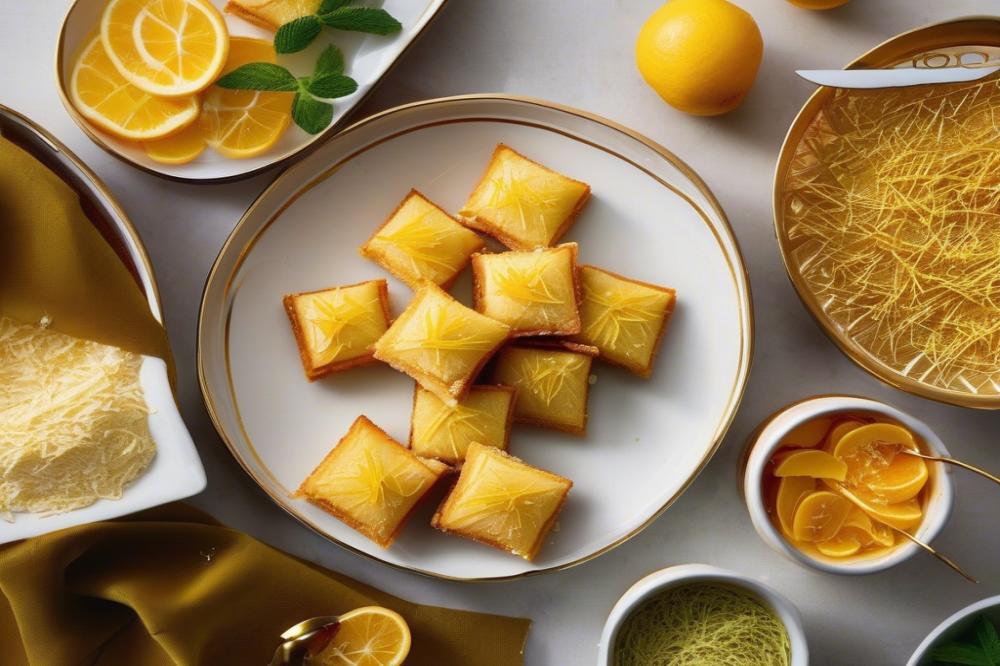Introduction
In the rich tapestry of Greek cuisine, one dessert stands out for its crispy texture and delicious flavors: kataifi. This traditional Greek sweet pastry is made with thin strands of dough known as phyllo dough. Often filled with finely chopped nuts and drenched in fragrant syrup, kataifi is a delightful treat that captures the essence of celebration and hospitality in Greek culture.
The history of this dessert reveals fascinating connections between Greece and the Middle East. Over centuries, various cultures have woven their baking traditions, and kataifi is a testament to that culinary blending. Origins can be traced back to the Ottoman Empire, where similar desserts first enchanted palates. As it transformed through the ages, Greece embraced kataifi, making it a staple in their dessert repertoire.
Authenticity is key when it comes to traditional Greek recipes. A genuine Kataifi Recipe not only uses the right ingredients but also respects the techniques passed down through generations. Each family might have its own twist, yet all reflect the commitment to quality and flavor. Creating this delightful treat at home allows one to connect with Greek food history while enjoying the process of baking.
The layers of phyllo dough come together to create a unique texture that offers a satisfying crunch. Inside, the nuts lend richness that pairs perfectly with the sweetness of the syrup. Enjoying a slice of kataifi often brings memories of family gatherings and festive occasions. This dessert symbolizes more than just a sweet ending to a meal; it embodies the warmth of Greek hospitality and the joy of sharing food with loved ones.
Greek Kataifi: Ingredients and Cooking Instructions
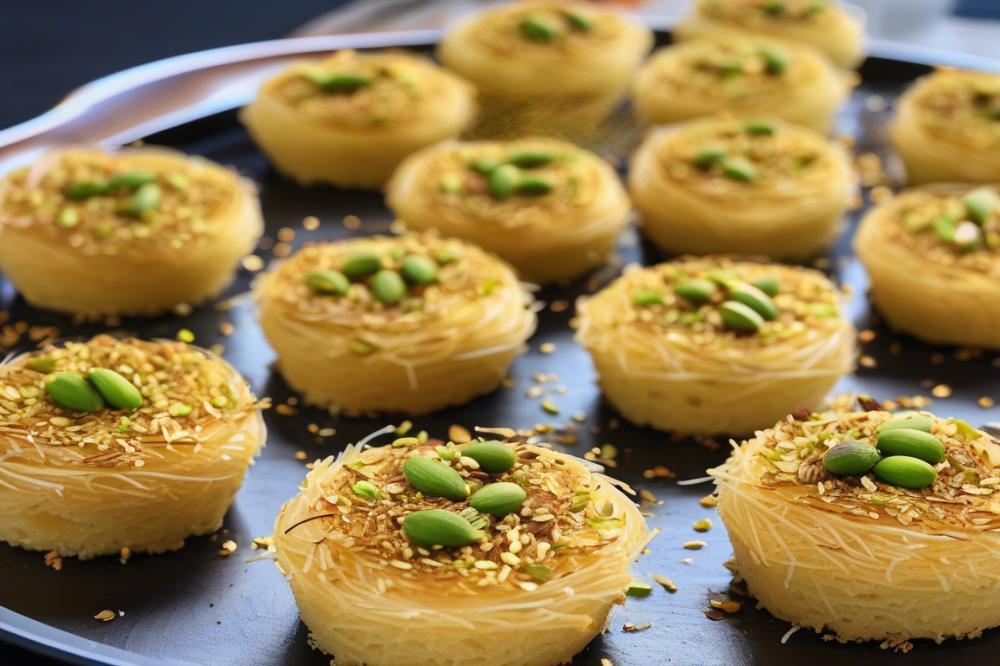
This delightful dessert features layers of kataifi pastry, a type of shredded phyllo dough. It is popular in both traditional Greek and Middle Eastern cuisines. The sweet pastry often highlights the rich flavors of nuts and syrup, making it a favorite at many gatherings.
Ingredients List
- 400g kataifi pastry
- 200g unsalted butter, melted
- 200g walnuts, chopped
- 100g almonds, chopped or slivered
- 200g sugar
- 1 teaspoon cinnamon
- 250ml water
- 1 tablespoon lemon juice
- Optional: 1 teaspoon vanilla extract
Cooking Instructions
Start by preheating your oven to 180°C (350°F). This temperature helps achieve that perfect golden hue for your dessert. Next, take the kataifi pastry and separate the strands. This process may seem a little tedious but is important for even baking.
In a mixing bowl, combine the chopped nuts, sugar, and cinnamon. The blend of flavors is key to a rich filling. Take a greased baking dish and layer the kataifi, brushing melted butter between layers. Make sure that every strand gets a little butter for that delicious crispy texture.
Sprinkle the nut mixture generously between the layers of pastry. This adds both flavor and crunch. Bake in the preheated oven for 30 to 40 minutes. Watch for a nice golden color on top, which indicates that the kataifi is ready.
While the pastry is baking, prepare the syrup. In a saucepan, boil together the water, sugar, lemon juice, and optional vanilla extract. Allow this mixture to simmer until it thickens slightly. The syrup brings everything together with its sweet and tangy flavor.
Once baked, pour the hot syrup over the kataifi. This step is crucial as it seeps into the pastry, infusing every layer with sweetness. Allow the dessert to cool before serving. This rest period lets the flavors meld beautifully.
Nutritional Information
Each ingredient contributes to the overall nutritional profile of this dish. Here’s a breakdown:
- Kataifi pastry (400g): Approximately 1,300 calories, 40g fat, 210g carbohydrates, 20g protein.
- Unsalted butter (200g): Approximately 1,400 calories, 160g fat, 0g carbohydrates, 0g protein.
- Walnuts (200g): Approximately 1,300 calories, 130g fat, 28g carbohydrates, 30g protein.
- Almonds (100g): Approximately 600 calories, 50g fat, 20g carbohydrates, 20g protein.
- Sugar (200g): Approximately 800 calories, 0g fat, 200g carbohydrates, 0g protein.
- Cinnamon (1 teaspoon): Approximately 6 calories, 0g fat, 2g carbohydrates, 0g protein.
- Water (250ml): 0 calories.
- Lemon juice (1 tablespoon): Approximately 4 calories, 0g fat, 1g carbohydrates, 0g protein.
- Vanilla extract (optional): Approximately 12 calories, 0g fat, 0g carbohydrates, 0g protein.
Overall, the entire dish contains a considerable amount of calories, fats, and carbohydrates primarily sourced from the pastry and nuts. Nutritional values can vary based on the specific products used.
The Tradition Behind Greek Kataifi
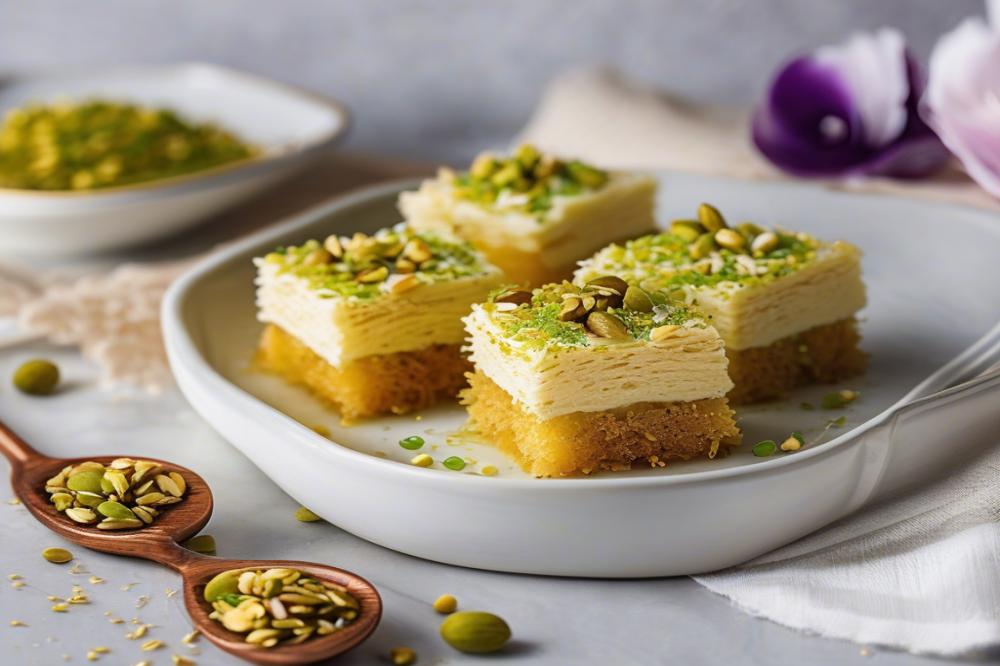
Kataifi has its roots deep in the culinary traditions of Greece and the Middle East. This dessert showcases the wonders of phyllo dough, which is used to create its signature shredded texture. Historians believe that this sweet pastry traces back centuries, influenced by various cultures over time. Many people enjoy this delicacy during special occasions, especially during festivals and family gatherings.
Cultural significance surrounds kataifi, making it more than just a dessert. Families prepare it during holidays like Easter and Christmas, serving it as a symbol of celebration. The process of baking this delight brings loved ones together in the kitchen. Everyone participates, sharing stories and laughter while rolling the dough and stuffing it with a rich mixture of nuts.
Traditional Greek recipes for kataifi often highlight the importance of family and heritage. The nuts used inside the pastry, such as walnuts or pistachios, add texture and flavor. Many people have their own unique recipes, passed down through generations. Each family adds a special touch, reflecting their history and customs.
After baking, the kataifi is traditionally soaked in a warm syrup. This syrup is usually made from sugar, water, and sometimes a hint of lemon juice or orange blossom water. This step is crucial, as it enhances the layers of dough, providing a sweet, sticky coating that holds everything together. The final result is a beautiful golden dessert, enticingly fragrant and bursting with flavor.
Baking kataifi may seem daunting, but many find it to be an easy recipe once they understand the steps. With a little patience, anyone can recreate this beloved dish at home. This dessert not only delights the taste buds but also connects people to their food history. The blend of flavors and textures, combined with the rich traditions surrounding its preparation, makes kataifi a cherished favorite in many households.
Tips for Perfecting Your Greek Kataifi
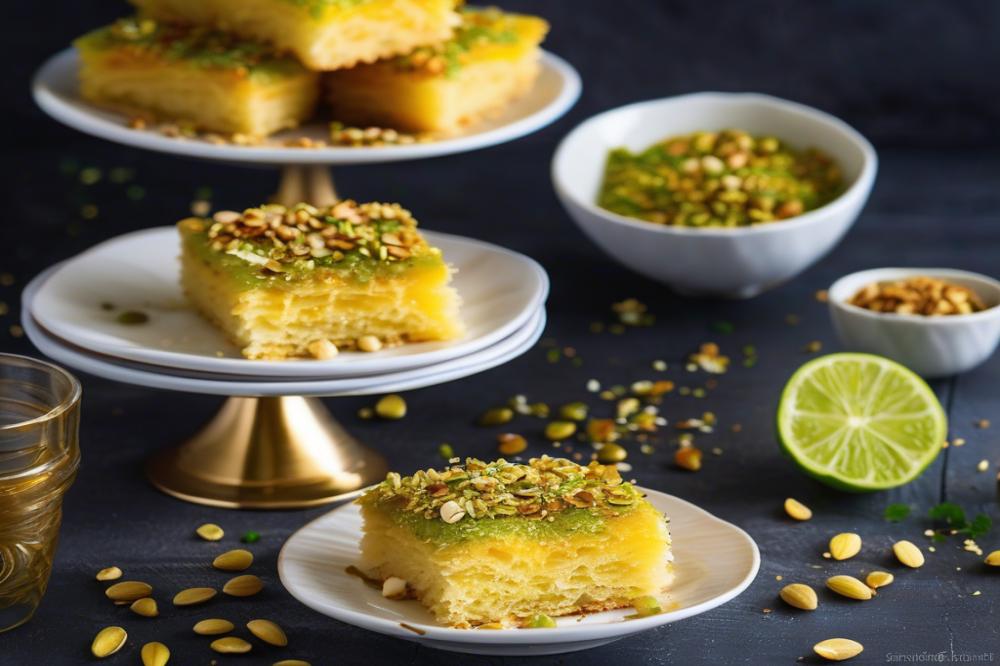
When working with phyllo dough, one must be gentle yet deliberate. Thaw the dough thoroughly before use. Cold dough tends to tear easily, making it challenging to work with. Lay a damp cloth over any unused sheets to maintain moisture. This simple step prevents the delicate sheets from drying out and cracking.
Mistakes can happen, but they can be avoided with a bit of attention. Overfilling the rolls is a common pitfall. Too much filling can cause them to burst during baking. Use just enough to keep the filling secure but not overflowing. Many novice bakers may also forget to apply butter between the layers of the phyllo. This practice adds flavor and helps achieve that beautiful golden color. A light touch with the brush is all you need.
For those seeking flavor variations, consider using different nuts. Walnuts are traditional, but trying pistachios offers a unique twist. Other choices like almonds or hazelnuts can add extra crunch and richness to the sweet pastry. You could also explore spices like cinnamon or cardamom for an aromatic touch. A bit of grated orange or lemon zest can brighten the flavors, too.
Baking times can vary based on your oven and the thickness of your layers. Keep an eye on the dessert to avoid over-baking. The goal is a crisp exterior that contrasts beautifully with the soft, nutty filling. Right when it comes out of the oven, drizzle warm syrup generously over the kataifi. This step transforms your dessert into a vibrant dish reminiscent of traditional Greek and Middle Eastern sweets.
Always remember, food history is rich with stories. Each ingredient you choose can tell a different tale, merging flavors from various cultures. Experimentation is part of the process. Find what works best for your taste and enjoy making the dessert uniquely yours.
Serving Suggestions and Pairings
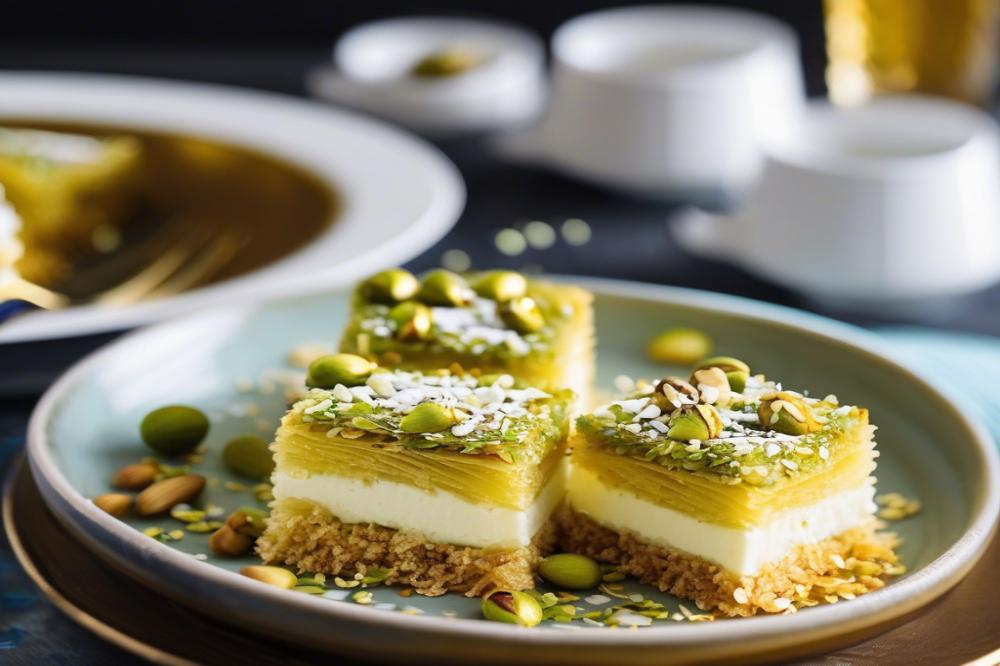
Greek kataifi is a delightful dessert that can be served in various appealing ways. When it comes to presentation, consider placing each serving on a decorative plate. Using a sprinkle of powdered sugar on top adds a touch of elegance. A dollop of whipped cream or a scoop of vanilla ice cream can elevate the dish. These creamy additions contrast perfectly with the crispy texture of the sweet pastry.
Creating a visual contrast can boost the experience. Serving on contrasting colored plates enhances the dish’s overall look. Pairing it with some fresh seasonal fruits, like berries or citrus slices, brings a vibrant touch. The freshness of the fruits balances well with the richness of the dessert.
Recommended Beverages
A strong cup of Greek coffee pairs excellently with kataifi. The bitterness of the coffee complements the sweetness of the syrup. Another great option is herbal tea, which adds a soothing quality to the meal. For those who prefer something refreshing, a glass of chilled lemonade could also work well.
When hosting a gathering, think about offering a variety of drinks. This ensures that every guest finds something they enjoy. Middle Eastern tea, with its aromatic spices, provides a unique experience that blends nicely with the flavors of the dessert.
Garnishing for Enhanced Experience
Nuts play a significant role in the presentation and flavor. Chopped pistachios or walnuts sprinkled on top gives a crunchy texture. Drizzling a bit of honey over the kataifi can also enhance the sweetness and contrast with the syrup. These details not only improve the taste but also make the dish look more inviting.
Cinnamon can add a warm and inviting aroma. Dusting a pinch on top invites guests to explore the dessert’s rich layers. A few mint leaves can freshen the presentation, making it appealing to the eye. These small touches bring complexity and can turn an easy recipe into an exquisite treat worthy of any celebration.
Variations of Traditional Greek Kataifi
Exploring the world of dessert can lead to exciting discoveries. Many people love the traditional Greek sweet pastry. Kataifi, with its thin strands of phyllo dough, creates a delightful texture. Variations are abundant, especially as more chefs put their spin on this classic recipe.
Innovative ingredients are becoming quite popular. Some like to add different nuts, such as pistachios or walnuts, to the filling. Others may choose to stuff theirs with sweetened cheese for a rich flavor. The sweetness often comes from a syrup infused with orange blossom or rosewater. These flavors can transport anyone to the sunny shores of Greece.
Regional variations also play a significant role in how this dish is prepared. Different areas in Greece might use a variety of nuts or spices to make their version special. Some might sprinkle cinnamon throughout, while others might create layers of different fillings for extra taste. The choices seem endless, adding a unique touch to every baking experience.
Similar desserts can be found in Middle Eastern cuisine, each with its own twist. For instance, baklava uses layers of phyllo dough, but it often has a honey or syrup glaze and a nut mixture. As the two culinary worlds overlap, similarities arise, showcasing a rich food history. The blend of flavors can create a delicious experience for anyone willing to try.
If you’re looking for an easy recipe, consider experimenting with your ingredients. Try substituting the usual nuts with something more adventurous, like hazelnuts or almonds. Adjust the sweetness of the syrup to match your taste. These small changes can make each batch of this beloved dessert even more memorable.
With every variation, there’s an opportunity to savor the essence of both traditional and modern flavors. Each bite can tell a story of culture and heritage, merging old recipes with new ideas.
Final Thoughts on Crafting Greek Kataifi
Making authentic kataifi is not just a cooking task; it’s an experience filled with tradition. Key points are essential to remember. Firstly, using high-quality ingredients plays a critical role in the overall taste and texture. Fresh nuts, fragrant spices, and sweet syrup can elevate this dessert to new heights. Next, following traditional methods brings authenticity to each step. Patience and care in crafting the phyllo dough strands are vital. They should be thin and delicate, ensuring that crispy layers form beautifully.
Many find joy in preparing this delicacy at home. It connects you to Greek culture in a simple yet profound way. The process might seem challenging at first, but it’s rewarding. With practice, the steps become more familiar. Your kitchen can become a hub of delicious aromas and flavors, enchanting friends and family alike.
Lastly, don’t hesitate to experiment while maintaining the core elements of the recipe. Personal touches can make your kataifi unique to your palate. Yet, keeping the essence of this traditional sweet intact is key. So roll up your sleeves and give it a try! You may discover a love for this beloved dessert that inspires countless gatherings and celebrations.

